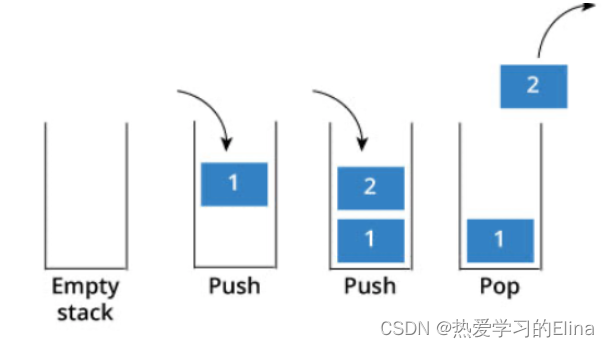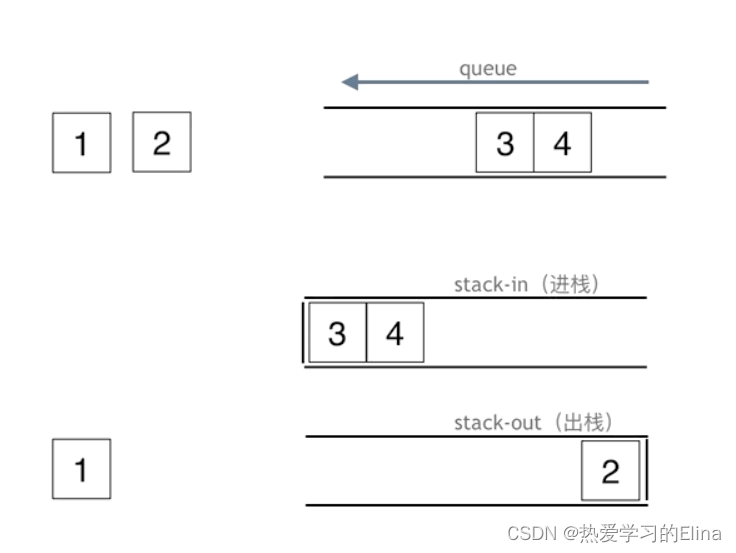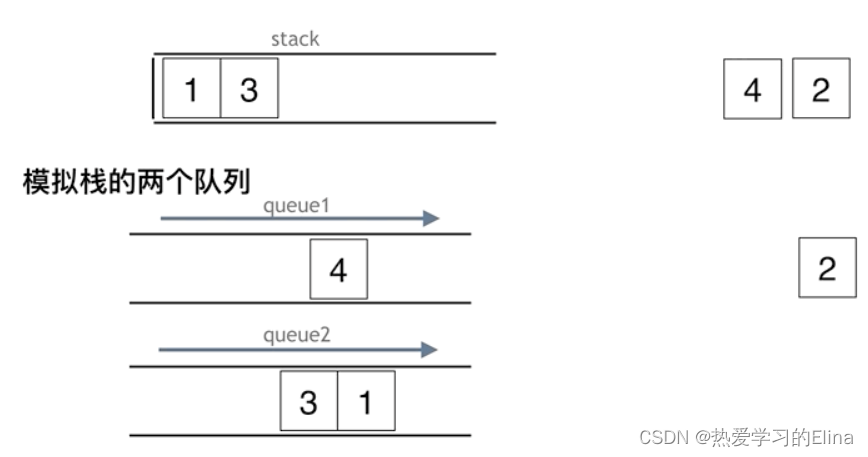代码随想录算法训练营Day10|232.用栈实现队列、225. 用队列实现栈
发布时间:2024年01月07日
理论基础
队列是先进先出,栈是先进后出。Java中的栈与队列介绍可以访问链接:Java数据结构中的栈和队列(带图解)

Stack方法:
| 方法 | 功能 |
|---|---|
| Stack() | 构造一个空栈 |
| E push(E e) | 将e入栈,并返回e |
| E pop() | 将栈顶元素出栈并返回 |
| E peek() | 获取栈顶元素 |
| int size() | 获取栈中有效元素个数 |
| boolean empty() | 检测栈是否为空 |
Queue方法:
| 方法 | 功能 |
|---|---|
| boolean o?er(E e) | 入队列 |
| E poll() | 出队列 |
| peek() | 获取队列头元素 |
| int size() | 获取队列中有效元素个数 |
| boolean empty() | 检测队列是否为空 |
一、232.用栈实现队列
题目描述: 使用栈实现队列的下列操作:
push(x) – 将一个元素放入队列的尾部。
pop() – 从队列首部移除元素。
peek() – 返回队列首部的元素。
empty() – 返回队列是否为空。
1. 双栈
将一个栈作为输入栈,用于压入
push传入的数据;另一个栈作为输出栈,用于pop和peak操作。
每次pop和peak时,若输出栈为空则将输入栈的全部数据依次弹出并压入输出栈,这样输出栈从栈顶往栈底的顺序就是队列从队首往队尾的顺序。
- 时间复杂度: O ( 1 ) O(1) O(1)
- 空间复杂度: O ( n ) O(n) O(n)

class MyQueue {
Deque<Integer> inStack;
Deque<Integer> outStack;
public MyQueue() {
inStack = new ArrayDeque<Integer>();
outStack = new ArrayDeque<Integer>();
}
public void push(int x) {
inStack.push(x);
}
public int pop() {
if (outStack.isEmpty()) {
in2out();
}
return outStack.pop();
}
public int peek() {
if (outStack.isEmpty()) {
in2out();
}
return outStack.peek();
}
public boolean empty() {
return inStack.isEmpty() && outStack.isEmpty();
}
private void in2out() {
while (!inStack.isEmpty()) {
outStack.push(inStack.pop());
}
}
}
/**
* Your MyQueue object will be instantiated and called as such:
* MyQueue obj = new MyQueue();
* obj.push(x);
* int param_2 = obj.pop();
* int param_3 = obj.peek();
* boolean param_4 = obj.empty();
*/
二、225. 用队列实现栈
题目描述: 使用队列实现栈的下列操作:
push(x) – 元素 x 入栈
pop() – 移除栈顶元素
top() – 获取栈顶元素
empty() – 返回栈是否为空
1. 两个队列
- 为了满足栈的特性,即最后入栈的元素最先出栈,在使用队列实现栈时,应满足队列前端的元素是最后入栈的元素。可以使用两个队列实现栈的操作,其中
queue1用于存储栈内的元素,queue2作为入栈操作的辅助队列。- 入栈操作时,首先将元素入队到
queue2,然后将queue1的全部元素依次出队并入队到queue2,此时queue2的前端的元素即为新入栈的元素,再将queue1和queue2互换,则queue1的元素即为栈内的元素,queue1的前端和后端分别对应栈顶和栈底。- 由于每次入栈操作都确保
queue1的前端元素为栈顶元素,因此出栈操作和获得栈顶元素操作都可以简单实现。出栈操作只需要移除queue1的前端元素并返回即可,获得栈顶元素操作只需要获得 queue1 的前端元素并返回即可(不移除元素)。由于queue1用于存储栈内的元素,判断栈是否为空时,只需要判断queue1是否为空即可。
- 时间复杂度: O ( n ) O(n) O(n)
- 空间复杂度: O ( n ) O(n) O(n)

class MyStack {
Queue<Integer> queue1;
Queue<Integer> queue2;
public MyStack() {
queue1 = new LinkedList<Integer>();
queue2 = new LinkedList<Integer>();
}
public void push(int x) {
queue2.offer(x);
while (!queue1.isEmpty()) {
queue2.offer(queue1.poll());
}
Queue<Integer> temp = queue1;
queue1 = queue2;
queue2 = temp;
}
public int pop() {
return queue1.poll();
}
public int top() {
return queue1.peek();
}
public boolean empty() {
return queue1.isEmpty();
}
}
/**
* Your MyStack object will be instantiated and called as such:
* MyStack obj = new MyStack();
* obj.push(x);
* int param_2 = obj.pop();
* int param_3 = obj.top();
* boolean param_4 = obj.empty();
*/
2. 一个队列
此过程简言之:队尾元素去队头,通过一个类似循环的方式形成栈。详细描述如下:
- 使用一个队列时,为了满足栈的特性,即最后入栈的元素最先出栈,同样需要满足队列前端的元素是最后入栈的元素。
- 入栈操作时,首先获得入栈前的元素个数
n,然后将元素入队到队列,再将队列中的前n个元素(即除了新入栈的元素之外的全部元素)依次出队并入队到队列,此时队列的前端的元素即为新入栈的元素,且队列的前端和后端分别对应栈顶和栈底。- 由于每次入栈操作都确保队列的前端元素为栈顶元素,因此出栈操作和获得栈顶元素操作都可以简单实现。出栈操作只需要移除队列的前端元素并返回即可,获得栈顶元素操作只需要获得队列的前端元素并返回即可(不移除元素)。
- 由于队列用于存储栈内的元素,判断栈是否为空时,只需要判断队列是否为空即可。
- 时间复杂度: O ( n ) O(n) O(n)
- 空间复杂度: O ( n ) O(n) O(n)
class MyStack {
Queue<Integer> queue;
public MyStack() {
queue = new LinkedList<Integer>();
}
public void push(int x) {
int n = queue.size();
queue.offer(x);
for (int i = 0; i < n; i++) {
queue.offer(queue.poll());
}
}
public int pop() {
return queue.poll();
}
public int top() {
return queue.peek();
}
public boolean empty() {
return queue.isEmpty();
}
}
总结
以上就是今天学习的内容,掌握 队列是先进先出,栈是先进后出 原则。
文章来源:https://blog.csdn.net/qq_41929830/article/details/135401453
本文来自互联网用户投稿,该文观点仅代表作者本人,不代表本站立场。本站仅提供信息存储空间服务,不拥有所有权,不承担相关法律责任。 如若内容造成侵权/违法违规/事实不符,请联系我的编程经验分享网邮箱:chenni525@qq.com进行投诉反馈,一经查实,立即删除!
本文来自互联网用户投稿,该文观点仅代表作者本人,不代表本站立场。本站仅提供信息存储空间服务,不拥有所有权,不承担相关法律责任。 如若内容造成侵权/违法违规/事实不符,请联系我的编程经验分享网邮箱:chenni525@qq.com进行投诉反馈,一经查实,立即删除!
最新文章
- Python教程
- 深入理解 MySQL 中的 HAVING 关键字和聚合函数
- Qt之QChar编码(1)
- MyBatis入门基础篇
- 用Python脚本实现FFmpeg批量转换
- 如何更好的去理解源码
- Java的CAS原理与应用
- 2024年华为OD机试真题-手机App防沉迷系统-Java-OD统一考试(C卷)
- 基于若依的ruoyi-nbcio流程管理系统一种简单的动态表单模拟测试实现(三)
- WiFi+蓝牙物联网定制方案——五大核心难点
- GIS项目实战07:Eclipse资源分享
- 一种缩小数据之间差距的算法
- 漫漫数学之旅002
- C++继承
- 【PostgreSQL】数据查询-WITH查询(公共表表达式)